February 6th, 2012
The method of using hair from other parts of the body to be placed into the scalp has been used for several years now. The Unfortunate thing is the change which occurs in the life cycle of body hair makes body hair the last option for scalp hair restoration. Body hair tends to have a long resting phase and short growth phase, meaning the majority of the hair which was transplanted will stay in the resting phase and have no visible hair growth.
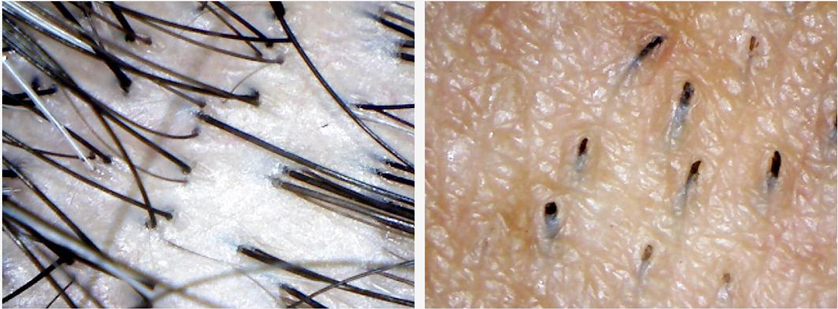
When seeing a side-by-side comparison of the scalp hair (left) vs. the facial hair (right), there is an obvious difference in the density of hair on the surface area and the average number of hairs in each follicular unit. Scalp hair is denser with more hair per grafts (over 2-4 hair/graft) while beard hair has less density with fewer hair per grafts (1-2 hair/graft)
On the other hand, mustache and beard hair has a shorter resting phase and longer growth phase. Because of this, men can grow their facial hair very long. For most people, facial hair is much thicker than scalp hair. Thicker hair could be translated as more bulk of hair after hair transplantation. Both thicker hair shafts and longer growth phase make beard hair a better option for scalp hair restoration in comparison to body hair transplant from other areas.
Unfortunately, there are two issues with beard hair restoration. The first is the fact they are very sparse, and removing hair only needs to be done through a strip procedure. The second regarding using facial hair for scalp transplant is follicular units found on the face have a fewer number of hairs per unit, which means there is less hair per grafts removed with FUE techniques.
Beard transplants are gaining popularity annually, and the newest technology in hair transplantation allows for hair loss doctors to use scalp hair for transplanting to the balding area in people which do not have good quality facial hair. Modern technology continues to advance the art and science of hair restoration further into new realms of possibilities, with an large annual growth reported yearly.
Tags: body hair transplant, Facial Hair Transplant, hair grafts
Posted in hair transplant, Hair Transplant Procedure | No Comments »
January 20th, 2012
The fact is, we are genetically predisposed in many ways. Our physical makeup may favor one parent over another, but as we become more acquainted with different family members on both sides, we start to find common traits with various members from our families. Though one parental side may be more dominate over the other, our hair and the loss thereof, to a significant point, is also hereditary.
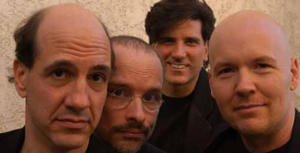
Perhaps you know someone who in their teens or early twenties started to experience thinning hair, the odds are the culprit is hidden in that complex of genetic code we call our ‘family tree.’
Hereditary hair loss is characterized by:
• Progressive miniaturization of hair follicles
• Shortening of the hair’s growth cycle
• The growth phase decreases
• Hair becomes thinner and shorter
• Eventually, the graft ceases to exist.
Modern Advances in hair restoration have made male-pattern and female-pattern androgenetic alopecia very treatable. Many men and women have enhanced their self image and esteem through successful hair restoration under the guidance of a highly skilled and qualified hair restoration medical doctor. MPB and FPB are common and today’s medical professionals have been paying attention the result being that both surgical and medical hair loss treatments have high rates of success.
Because hereditary hair loss is gradual, the sooner treatment is started, the better the chances of results. Checking your family tree to see if you have a possible genetic predisposition to hair loss might help you recognize the symptoms early enough to slow the progression.
Tags: alopecia, family history, Genetic Predispositions, hereditary hair loss
Posted in General Information, Hair Loss Conditions, Hair Loss Conversations, women hair loss | No Comments »
January 4th, 2012
At US Hair Restoration we are beginning a new Webinar series that allows for patients and onlookers to connect with Dr. Parsa Mohebi and ask any hair loss questions they may have directly. Each webinar will focus on different topics like “Why does balding actually happens” and “Breakthrough technology in Hair Restoration.” Each webinar will be equipped with a time of introduction, informative conversation about hair loss, hair restoration, latest techniques of hair restoration, and much more. There will also be a Q & A time which may include special incentives for those who are interested in a hair loss consultation and hair transplantation.
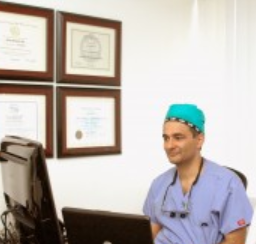 We are excited at having this time for answering the many different questions given by people who want more knowledge about the art and science of hair restoration, as well as those who simply want to know what they can personally gain from hair restoration. We constantly receive hair loss and hair restoration questions which come to US Hair Restoration and get answered over the phone, email, or through our blog. In spite of these available resources, many feel they don’t have answers for their questions. This hair restoration webinar series will give place for those questions to be answered in an open forum where Dr. Mohebi is available to answer all the questions himself. This is a great way to start the New Year off with an innovative, more personal way to connect to individuals. We are excited at having this time for answering the many different questions given by people who want more knowledge about the art and science of hair restoration, as well as those who simply want to know what they can personally gain from hair restoration. We constantly receive hair loss and hair restoration questions which come to US Hair Restoration and get answered over the phone, email, or through our blog. In spite of these available resources, many feel they don’t have answers for their questions. This hair restoration webinar series will give place for those questions to be answered in an open forum where Dr. Mohebi is available to answer all the questions himself. This is a great way to start the New Year off with an innovative, more personal way to connect to individuals.
January 9th, 2012 at 6 PM (PST) is when our first Webinar begins. We are excited to expand the ways we can stay in touch with everyone and hope to see you all there!!Spaces are limited, and on a first come, first serve basis. Contact us at Webinar@ushairrestoration.com or call us at (888) 302-8747 and we will be happy to add you to the fun!!
Tags: Dr. Parsa Mohebi, Hair Loss Conversations, us hair restoration, Webinar
Posted in Hair Loss Conversations, Hair Loss Webinar | No Comments »
December 23rd, 2011
 It is most common for people consider hair transplant surgery as one remedy for hair loss and balding, which is true in most cases. Modern day hair restoration is the only natural, permanent and proven treatment option for hair loss, which continues to improve the lives of thousands of individuals every year. It is most common for people consider hair transplant surgery as one remedy for hair loss and balding, which is true in most cases. Modern day hair restoration is the only natural, permanent and proven treatment option for hair loss, which continues to improve the lives of thousands of individuals every year.
There are times when hair transplant surgery has absolutely nothing to do with restoring hairs which have been lost, but for creating facial symmetry and proportion which may have never existed.
The famed artist Michelangelo referred to this as “the rule of thirds”, the proportional frame of the human face, where the hairline acts as the top of the frame and the chin as the bottom. These “thirds” are evenly spaced sections that give the face an attractive, aligned appearance: the hairline to the top of the eyebrow, the top of the eyebrow to the base of the nose, the base of the nose to the bottom of the chin. When there is even a slight variance in this rule, the face looks out of proportion. When it is the hairline that is positioned beyond its desired starting point, the individual tends to look older than they actually are.
Creating this proportion and facial symmetry in both men and women with naturally receded hairlines is treatable through modern day hair transplantation. Using the rule of thirds, a qualified hair transplant surgeon will design the perfect hairline placement and starting point, which is individualized for each patient. Then employing a blend of artistry and hair transplant surgical training, this new hairline will mirror the natural growth pattern of the hair, and will act as the perfect top frame to the face.
Tags: balding, hair loss, receding hair lines, Rule of thirds
Posted in General Information | No Comments »
November 19th, 2011
 Here at US Hair Restoration, we often get phone calls and emails regarding different hair loss shampoos which propose major claims to successfully re-grow hair, or prevent hair loss. Some of these products maintain having ingredients such as Minoxidil, which actually is a proven hair loss medication. The setback of the majority of these products and claims has to do with the duration of time which they remain on the scalp. In order for them to work properly, they must remain on the scalp for a length of time which is needed to be absorbed into the skin. Here at US Hair Restoration, we often get phone calls and emails regarding different hair loss shampoos which propose major claims to successfully re-grow hair, or prevent hair loss. Some of these products maintain having ingredients such as Minoxidil, which actually is a proven hair loss medication. The setback of the majority of these products and claims has to do with the duration of time which they remain on the scalp. In order for them to work properly, they must remain on the scalp for a length of time which is needed to be absorbed into the skin.
Of all the topical hair loss products available today, Minoxidil is the most effective. At US Hair Restoration we recommend the simple use of it being applied twice a day, and then left on the scalp for maximizing its effectiveness. There are many products which advertise their contents having minerals and vitamins which have no true effectiveness, because the ingredients are not absorbed by the skin on the scalp. There are several brands to choose from with big claims, but Minoxidil is the only one which is FDA approved and actually proven to prevent hair loss.
Posted in hair loss medication, hair loss products | No Comments »
November 7th, 2011
There are often occasions when we receive inquiries about the latest hair transplant technology, and we feel an obligation to spread the news about these current updates. The field of hair restoration now has the new generation of Laxometer, which is the newest hair transplant device invented by Dr. Parsa Mohebi. The Laxometer II is a handheld tool which transforms the art and science of hair restoration. Since hair restoration is a growing sector of the cosmetic surgery arena, progressive updates on hair transplant new technology is necessary.
What Does It Do?
The Laxometer II enhances the quantity of hair grafts which can be transplanted precisely in one surgery. Once upon a time hair transplants of more than 3500 follicular grafts took more than one surgery to complete. With this revolutionary latest technology in hair transplantation, surgeries as such can be done in merely one procedure.
Being the newest technology in the hair transplant industry, the Laxometer II is a measuring device which is used to determine the laxity (elasticity) of one’s scalp. An accurate measurement of scalp laxity is critical when giving a precise determination of how large the donor strip should be. This latest breakthrough hair transplant technology gives a calculated measurement which can be increased when patients consistently do scalp exercises daily. The larger the available strip size, the more hair follicles can be transplanted.
During the 2011 International Society of Hair Restoration Surgery’s (ISHRS) Annual Scientific meeting in Alaska, Parsa Mohebi M.D. released this brand new invention for purchase by hair transplant surgeons. This latest technology in hair transplant surgery was warmly received with great anticipation and applause as it is going to help to continue the industry moving forward into a greater realm of success.
Posted in hair transplant | No Comments »
October 21st, 2011
 Hair loss and hair thinning is a result of testosterone formed in different areas like the prostate gland or hair follicles, which is converted to Dihydrotestosterone (DHT) in the scalp area. Hair follicles prone to genetic male patterned baldness contain DHT receptors, thus thinning hair and loss of hair can result. Over time men produce an abundance of DHT and the molecules affect their hair follicles and cause a decrease in size and eventually see their natural hair fall out permanently. Because of this common occurrence, hair loss in men is frequent. Hair loss and hair thinning is a result of testosterone formed in different areas like the prostate gland or hair follicles, which is converted to Dihydrotestosterone (DHT) in the scalp area. Hair follicles prone to genetic male patterned baldness contain DHT receptors, thus thinning hair and loss of hair can result. Over time men produce an abundance of DHT and the molecules affect their hair follicles and cause a decrease in size and eventually see their natural hair fall out permanently. Because of this common occurrence, hair loss in men is frequent.
DHT and hair loss from having the gene for male pattern baldness are the most common factors for male pattern baldness. Women suffering from female-pattern baldness, unlike their counterparts with male-pattern baldness, are not usually characterized by higher production rates of DHT from lower levels of testosterone. On the other hand, if for a number of possible reasons, a woman has increased testosterone, she can develop female patterned baldness like a man does through the same mechanism.
Hair in the prone areas to male patterned baldness: Corners, top, and crown are filled with DHT receptors in men who suffer Androgenic Alopecia The hair on donor areas such as back and sides, however, have fewer DHT receptors. This is precisely why hair is more permanent on the sides and back and not the top and front.
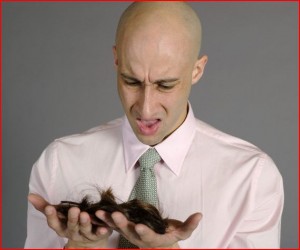
The distinction in the hair quality of different areas, such as the donor and recipient areas, allows for hair loss surgeons to remove the hair from one area and transplant it to the bald portions of the scalp. These newly transplanted hairs are permanent and immune to DHT. Finasteride (Propecia) is a drug which blocks the conversion of testosterone to DHT as a result of it blocking the enzyme alpha reductase. The amount of DHT in hair loss patients decrease when they are on Propecia and this helps to maintain healthy hair, and also helps some of the miniaturized hair become stronger.
We at US Hair Restoration often recommend medical treatment with DHT blockers in many of our patients who undergo a hair transplantation procedure in order to help maintain their own hair in addition to the newly restored, formerly balding areas because of a hair restoration surgery.
Tags: androgenetic alopecia, dht, DHT blockers, DHT receptors, dihydrotestosterone, female patterned baldness, finasteride, hair restoration surgery, propecia, testosteron
Posted in hair loss complications, Hair Loss Conditions, hair transplant, men hair restoration, women hair loss | No Comments »
October 7th, 2011
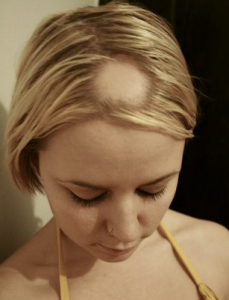 The autoimmune condition known as Alopecia causes hair loss in different areas of the body. These patchy, bald areas tend to look normal and don’t show any signs of inflammation or irritation. There is a genetic correlation found in some cases which can be linked to other autoimmune disorders. This particular form, Alopecia Areata, is most commonly a disease which is self-limiting, yet can be treated if necessary through steroid injections or topical medications by a dermatologist. The autoimmune condition known as Alopecia causes hair loss in different areas of the body. These patchy, bald areas tend to look normal and don’t show any signs of inflammation or irritation. There is a genetic correlation found in some cases which can be linked to other autoimmune disorders. This particular form, Alopecia Areata, is most commonly a disease which is self-limiting, yet can be treated if necessary through steroid injections or topical medications by a dermatologist.
The other form is known as Traction Alopecia which is common in children. This is a condition which is seen mainly in girls by having weak and fragile hair follicles. A common cause for this type of alopecia is tightly wrapped ponytails which in most cases affect the sides and front of the scalp. The initial sign of Traction Alopecia can be the elevation of the hairline. A way to treat this is by cutting the hair short and eliminating the strain the tightly wrapped hair causes on the follicles. The recovery time may take a few months and is spontaneous. In some of the longer term cases of Traction Alopecia, hair follicles are permanently damaged and a hair transplantation would be necessary to grow hair in the balding areas.
Tags: alopecia, alopecia areata, hair follicles, Traction Alopecia
Posted in Uncategorized | No Comments »
September 16th, 2011
There are times when patients suffering from the more advanced stages of balding require a second hair transplantation surgery to complete the process. The question many of these particular patients have is what the time lapse is between the first and second surgeries.
 This depends on if there is density which needs to be added to the already transplanted areas. If so, there needs to be at least six months which has passed since the original surgery. This is because after six months there is more complete growth from the first hair transplantation, and a touch up in the already transplanted areas will bring more complete results. The amount of hairs transplanted in the second surgery is typically less than the first since the scar from the first surgery is removed a second time. Overall, the greater the density in the transplanted areas, the better the hair restoration will look long term. This depends on if there is density which needs to be added to the already transplanted areas. If so, there needs to be at least six months which has passed since the original surgery. This is because after six months there is more complete growth from the first hair transplantation, and a touch up in the already transplanted areas will bring more complete results. The amount of hairs transplanted in the second surgery is typically less than the first since the scar from the first surgery is removed a second time. Overall, the greater the density in the transplanted areas, the better the hair restoration will look long term.
Tags: advanced stages of balding, hair transplantation surgery, second hair transplantation surgery
Posted in hair transplant, Hair Transplant Procedure, men hair restoration, Second hair transplant procedure, Uncategorized | No Comments »
September 3rd, 2011
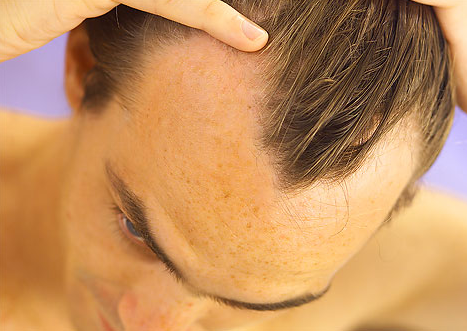 I am often asked questions by patients after their hair restoration surgery regarding how many transplanted hair grafts will fall out and never grow back. This question comes as a result of fear based on testimonies they have heard from patients who got a hair transplant several years ago from a different surgeon, at a time when the technology available was not as dependable as it is today. Also at times, they have heard of sad stories from the tabloids of celebrity hair restorations gone wrong. I am often asked questions by patients after their hair restoration surgery regarding how many transplanted hair grafts will fall out and never grow back. This question comes as a result of fear based on testimonies they have heard from patients who got a hair transplant several years ago from a different surgeon, at a time when the technology available was not as dependable as it is today. Also at times, they have heard of sad stories from the tabloids of celebrity hair restorations gone wrong.
At US Hair Restoration we pride ourselves on patient satisfaction, quality, up-to-date precise methods, and value. We at times get patients who have had hair loss procedures gone wrong from physicians using much older methods. They come to us to correct their past surgical errors and we gain their trust by giving them results which make them happy.
The fact of the matter is over 95% of transplanted hair grafts should permanently survive based on studies administered using microscopic follicular unit transplanted methods. These studies show anywhere from 95-99% are expected take hold and grow as healthy hairs within only a few months of a transplantation surgery.
Tags: celebrity hair restorations, follicular unit transplant, hair loss procedures, hair restoration surgery, hair transplant, transplantation surgery, transplanted hair grafts, us hair restoration
Posted in after hair transplant, hair transplant, hair transplant repair | No Comments »
|
|



 We are excited at having this time for answering the many different questions given by people who want more knowledge about the art and science of hair restoration, as well as those who simply want to know what they can personally gain from hair restoration. We constantly receive hair loss and hair restoration questions which come to US Hair Restoration and get answered over the phone, email, or through our blog. In spite of these available resources, many feel they don’t have answers for their questions. This hair restoration webinar series will give place for those questions to be answered in an open forum where Dr. Mohebi is available to answer all the questions himself. This is a great way to start the New Year off with an innovative, more personal way to connect to individuals.
We are excited at having this time for answering the many different questions given by people who want more knowledge about the art and science of hair restoration, as well as those who simply want to know what they can personally gain from hair restoration. We constantly receive hair loss and hair restoration questions which come to US Hair Restoration and get answered over the phone, email, or through our blog. In spite of these available resources, many feel they don’t have answers for their questions. This hair restoration webinar series will give place for those questions to be answered in an open forum where Dr. Mohebi is available to answer all the questions himself. This is a great way to start the New Year off with an innovative, more personal way to connect to individuals.


 Hair loss and hair thinning is a result of testosterone formed in different areas like the prostate gland or hair follicles, which is converted to Dihydrotestosterone (DHT) in the scalp area. Hair follicles prone to genetic male patterned baldness contain DHT receptors, thus thinning hair and loss of hair can result. Over time men produce an abundance of DHT and the molecules affect their hair follicles and cause a decrease in size and eventually see their natural hair fall out permanently. Because of this common occurrence, hair loss in men is frequent.
Hair loss and hair thinning is a result of testosterone formed in different areas like the prostate gland or hair follicles, which is converted to Dihydrotestosterone (DHT) in the scalp area. Hair follicles prone to genetic male patterned baldness contain DHT receptors, thus thinning hair and loss of hair can result. Over time men produce an abundance of DHT and the molecules affect their hair follicles and cause a decrease in size and eventually see their natural hair fall out permanently. Because of this common occurrence, hair loss in men is frequent.

 This depends on if there is density which needs to be added to the already transplanted areas. If so, there needs to be at least six months which has passed since the original surgery. This is because after six months there is more complete growth from the first hair transplantation, and a touch up in the already transplanted areas will bring more complete results. The amount of hairs transplanted in the second surgery is typically less than the first since the scar from the first surgery is removed a second time. Overall, the greater the density in the transplanted areas, the better the hair restoration will look long term.
This depends on if there is density which needs to be added to the already transplanted areas. If so, there needs to be at least six months which has passed since the original surgery. This is because after six months there is more complete growth from the first hair transplantation, and a touch up in the already transplanted areas will bring more complete results. The amount of hairs transplanted in the second surgery is typically less than the first since the scar from the first surgery is removed a second time. Overall, the greater the density in the transplanted areas, the better the hair restoration will look long term.